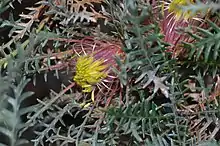| Banksia serratuloides | |
|---|---|
 | |
| Scientific classification | |
| Kingdom: | Plantae |
| Clade: | Tracheophytes |
| Clade: | Angiosperms |
| Clade: | Eudicots |
| Order: | Proteales |
| Family: | Proteaceae |
| Genus: | Banksia |
| Subgenus: | Banksia subg. Banksia |
| Series: | Banksia ser. Dryandra |
| Species: | B. serratuloides |
| Binomial name | |
| Banksia serratuloides | |
| Synonyms[1] | |
| |
Banksia serratuloides is a species of small shrub that is endemic to Western Australia. It has linear, pinnatipartite leaves, yellow and pink flowers in heads of about forty and hairy, wrinkled follicles.
Description
Banksia serratuloides is a shrub that typically grows to a height of 50 cm (20 in) and forms a lignotuber. It has hairy stems and leaves that are linear, pinnatipartite, 30–90 mm (1.2–3.5 in) long and 7–15 mm (0.28–0.59 in) wide on a petiole 10–20 mm (0.39–0.79 in) long. There are between six and fifteen or between twenty and thirty-three (depending on subspecies) triangular to lance-shaped lobes on each side of the leaves. Between thirty-five and forty yellow flowers are arranged in heads with egg-shaped to lance-shaped, shining brown involucral bracts 11–25 mm (0.43–0.98 in) long at the base of each head. The perianth is 19–23 mm (0.75–0.91 in) long and pink at the base, and the pistil is 22–29 mm (0.87–1.14 in) long and pink. Flowering occurs from July to September and the follicles are elliptical, 5–6 mm (0.20–0.24 in) long, wrinkled and densely hairy.[2][3]
Taxonomy and naming
This species was first formally described in 1855 by Carl Meissner who gave it the name Dryandra serratuloides and published the description in Hooker's Journal of Botany and Kew Garden Miscellany from specimens collected by James Drummond.[4][5] The specific epithet (serratuloides) refers to the similarity of this species to species in the genus Serratula.[6]
In 1996, Alex George described two subspecies in the journal Nuytsia:
- Dryandra serratuloides subsp. perissa has leaves with between six and twelve lobes on each side, and inner bracts 11–20 mm (0.43–0.79 in) long;
- Dryandra serratuloides subsp. serratuloides has leaves with between twenty and thirty-three lobes on each side, and inner bracts 22–25 mm (0.87–0.98 in) long.[7]
In 2007 Austin Mast and Kevin Thiele transferred all dryandras to the genus Banksia and renamed the species Banksia serratuloides and the subspecies perissa and serratuloides respectively.[8][9] The names B. serratuloides subsp. perissa and B. serratuloides subsp. serratuloides are accepted by the Australian Plant Census.[10][11]
Distribution and habit
Banksia serratuloides grows in kwongan or open shrubland and occurs in two disjunct areas between Eneabba and Mogumber.[3] Subspecies perissa is found between Alexander Morrison National Park, Badgingarra and Boothendarra Hill. Subspecies serratuloides occurs near Gillingarra and Mogumber.[3][7][12][13]
Conservation status
Banksia serratuloides is classified as "not threatened" by the Western Australian Government Department of Parks and Wildlife,[2] but both subspecies are listed as "Threatened Flora (Declared Rare Flora — Extant)" by the Department of Environment and Conservation (Western Australia).[12][13]
References
- 1 2 "Banksia serratuloides". Australian Plant Census. Retrieved 31 May 2020.
- 1 2 "Banksia serratuloides". FloraBase. Western Australian Government Department of Biodiversity, Conservation and Attractions.
- 1 2 3 George, Alex S. (1999). Flora of Australia (PDF). Vol. 17B. Canberra: Australian Biological Resources Study, Canberra. pp. 290–291. Retrieved 31 May 2020.
- ↑ "Dryandra serratuloides". APNI. Retrieved 31 May 2020.
- ↑ Meissner, Carl; Hooker, William J. (1855). "New Proteaceae of Australia". Hooker's Journal of Botany and Kew Garden Miscellany. 7: 123–124. Retrieved 31 May 2020.
- ↑ Francis Aubie Sharr (2019). Western Australian Plant Names and their Meanings. Kardinya, Western Australia: Four Gables Press. p. 306. ISBN 9780958034180.
- 1 2 George, Alex (1996). "New taxa and a new infrageneric classification in Dryandra R.Br. (Proteaceae : Grevilleoideae)". Nuytsia. 10 (3): 349–351. Retrieved 31 May 2020.
- ↑ Mast, Austin R.; Thiele, Kevin (2007). "The transfer of Dryandra R.Br. to Banksia L.f. (Proteaceae)". Australian Systematic Botany. 20 (1): 63–71. doi:10.1071/SB06016.
- ↑ "Banksia serratuloides". APNI. Retrieved 31 May 2020.
- ↑ "Banksia serratuloides subsp. perissa". Australian Plant Census. Retrieved 31 May 2020.
- ↑ "Banksia serratuloides subsp. serratuloides". Australian Plant Census. Retrieved 31 May 2020.
- 1 2 "Banksia serratuloides subsp. perissa". FloraBase. Western Australian Government Department of Biodiversity, Conservation and Attractions.
- 1 2 "Banksia serratuloides subsp. serratuloides". FloraBase. Western Australian Government Department of Biodiversity, Conservation and Attractions.
- Cavanagh, Tony; Pieroni, Margaret (2006). The Dryandras. Melbourne: Australian Plants Society (SGAP Victoria); Perth: Wildflower Society of Western Australia. ISBN 1-876473-54-1.